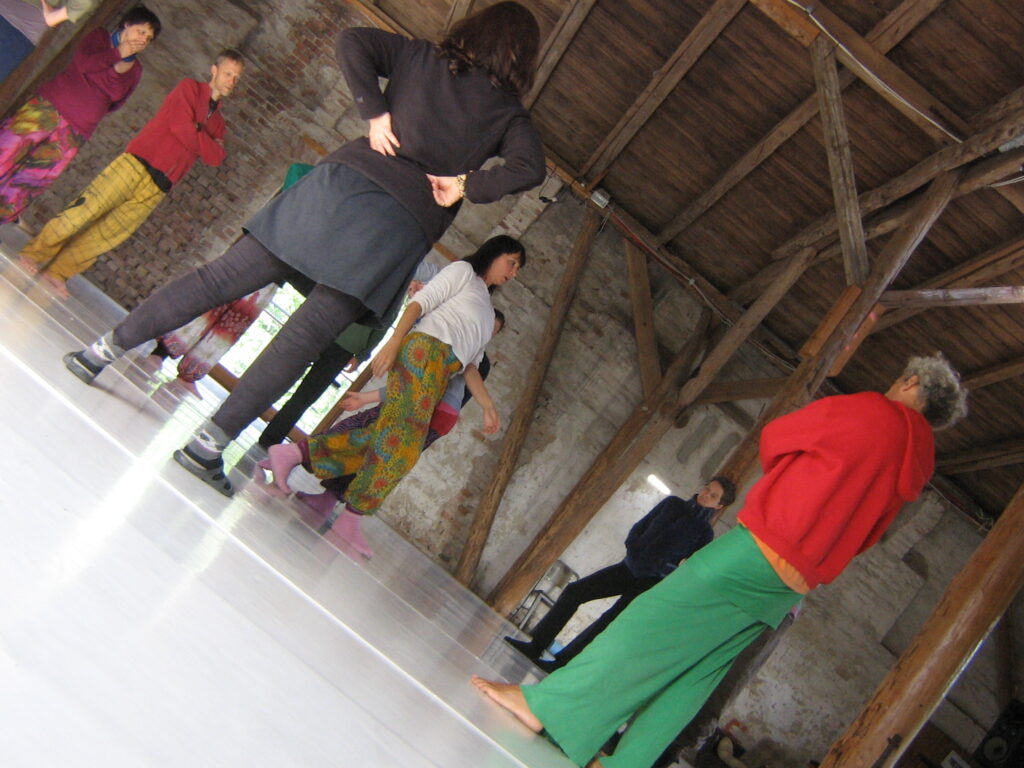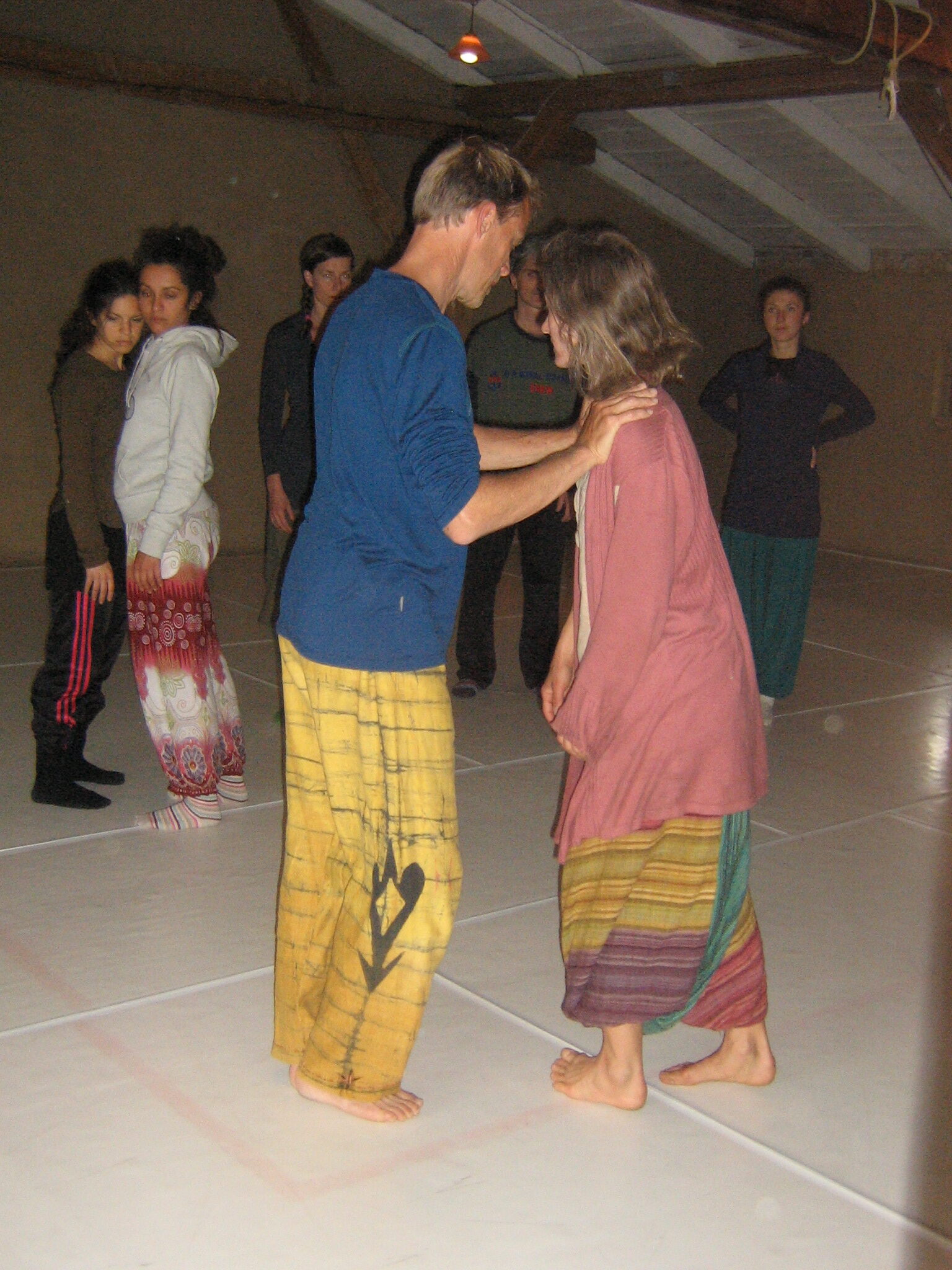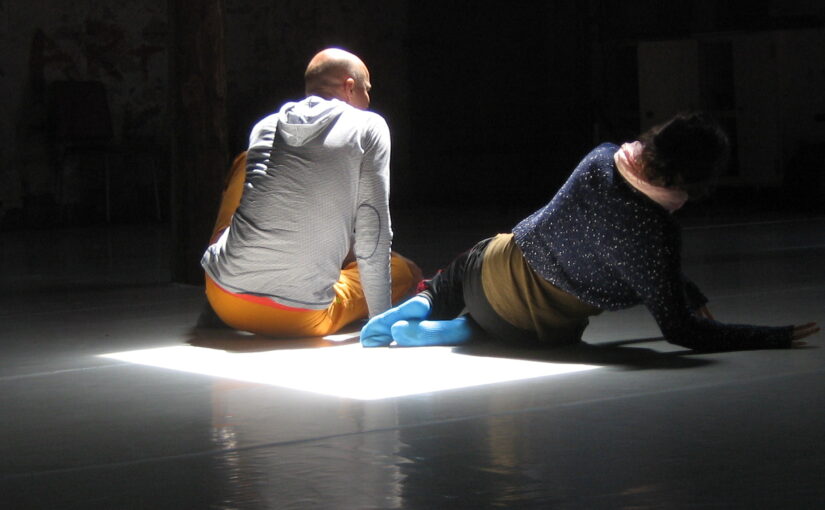In Summer 2015, I attended Tango Diferente – a week-long course combining Argentine tango and contact improvisation, organised by Adriana Pegorer. It was held at Ponderosa, Stolzenhagen on the German Polish border. I wrote an essay about it ‘Dancing the metaphor : impressions of Tango Diferente 2015’ which is presented here.
“How deliciously steeped with metaphor the world is. As dance artists we instinctively and essentially seek out images and connections that may expand and enliven our artistic practice, deepening our creativity and our capacity to embody as they shed light on the murkier aspects of sensation and perception …’
‘Metaphors help bridge the gap between the cortical and intuitive, supporting the articulation and owning of my experiences’
‘But my deepest appreciation of metaphors is that they are maps that guide me to adventures with new horizons and territories, as maps steering me home … offering a re-acquaintance, a deepening, and a richer intimacy with the inner world I experience as me’
Fiona Millward, dance artist and teacher [1]

I’ve been here before. “Halten Sie Stolzenhagen?” I say to the bus driver. I don’t understand his reply – my German is poor, and learned from teach-yourself books. Perhaps he said – you should have told me to stop back there! I disembark. A rolling landscape of crops waving in the breeze; an occasional copse; and on the horizon giant wind turbines. It’s easy to find the village of Stolzenhagen as all roads in its vicinity take you there. Nearby, to the east of the village is the river Oder which divides Germany and Poland. Follow the Oder north and you’d reach the Baltic Sea
(‘Die Ostsee’); to the south, the Czech Republic.
Tango Diferente is a week of dance; a research and teaching week combining elements of Argentine Tango; Queer Tango; Contact Improvisation; and body release based techniques. It is situated in these movement practices; and in the dance studios of converted barns and a farmhouse in Stolzenhagen.
On this occasion, June 2015 – the fourth Tango Diferente in as many years; another course is simultaneous taught by Kirstie Simson about improvisation in dance; last year it was a tantra week. The dance spaces and schedule of courses, are managed by ‘Ponderosa Movement & Discovery’ which has become synonymous with this place. People say, ‘I was at Ponderosa’. A particular culture dwells here, at Ponderosa: creative; exciting!; connected; embodied; co-operative; corporal; fringe; deviant; remade; reconstructed; priced; glam; silent; loud; young; brash; challenging; innovative; crazy! During a heavy thunderstorm, a few of the Ponderosa staff (volunteers and interns) – who cook and keep the spaces – abandon their clothes and frolic naked in the garden like new-born nymphs. But dinner still arrives on time.
Tango Differente

Tango Differente is organised by Adriana Pegorer. A schedule of dance classes and their teachers (our teachers) is posted at the beginning of the week; and the teachers are invited by Adriana. A welcoming circle at the start of the course with students, identifies their routes to this course – their dance journey: tango, contact improvisation, swing, and other dances. These many branches of dance and their embodiment in the students are the tributes of a river that are flowing into this place.
On the evening of the first day (Monday 15 June), Adriana gives an introductory class to essential elements of contact tango. We work in pairs. One person is ‘A’ and the other ‘B’ and we are introduced to four ‘forms’. Firstly, A stands to one side of B in contact with them at the shoulder; A then moves to the shoulder of B on their otherside and comes into contact with it; A then stands back-to-back with B; finally A stands front-to-front with B for the final form. The final form is reminiscent of tango where the two dancers – one leading the dance and other following – face each other. We swap over roles and repeat the exercise including facing opposite directions: eight combinations.
Now, we introduce walking with our partner, and maintaining our roles of leading and following. We use the four forms introduced earlier and continuously staying in contact with each other. One of the partners, leads the other by walking, stopping, slowing or quickening their pace and maintaining contact or changing the form/position. We swap the roles and repeat the exercise. Then we ‘blend’ the roles so that during the dance the roles are changing – in a dialogue, as is found in contact improvisation. The use of arms for contact is finally added so that we may gude our partner with a flexible embrace. Note: there is no weight bearing in this exercise: neither giving the weight of our body, our fall, to the other person or receiving weight from them. We could have used trios of people rather than pairs says Adriana but there are too few people here for that now. This exercise introduced new possibilities in dance to us, and helps to establish a vocabulary for contact tango.
Bio-mechanics

The Axis Syllabus is a body of teaching which Irina Hortin practices [2]. She co-teaches with Gabriele Koch (Tuesday 16 June). The understanding of the spine, connective tissue and the functioning of it are examined in this workshop through talking; touch and movement with our dance partners. Irina explains the structure of the spine and its vertebrae.
Three people are summoned to become the spine just below the head. One person sits on the floor – enthroned; two are standing either side their hands around the sitter, showing the degrees of movement; and finally Irina is above the head of the sitter. She is the Atlas vertebrae which is the first or topmost vertebrae; her arms loosely encircle the sitter’s head to demonstrate that the Atlas has a hollow ring like structure allowing side-to-side (rotational) and up-and-down (vertical) motion. Atlas, Irina explains, is the Greek god who holds the world above them. The world for us, being our head.
We work with a partner: one person places a finger of one hand at the sacrum – the base of the spine. With the other hand, a finger is pressed into the hollow at the base of the skull and the top of the spine. Thus we can guide and lead our partner in movement, and our partner senses the relation of these parts. Imagine ‘a ball on a spring of water’ says Irina. We also examine our walking; contact with the ground and our posture. Our spine is the ‘Serpent’s Spine’ and we are falling upwards. A cable is laid out on the ground and we walk it, as if it is a tightrope suspended at height.
Ritual and performance

One morning prior to the workshop starting, I am watching from a balcony on the farmhouse fire escape, and I see people from Ponderosa gathering in a circle. They are depositing rocks in a pile as if making an offering, and standing silently. Later, I ask one of the participants about it: a ceremony to welcome the new moon. It is a movement practice – irrespective of its purpose, and I reflect that perhaps it exposes the habituated routines in our lives too. Where is the performance situated? In the performers themselves? In me – the audience? Or there – the kitchen garden of this former Prussian farmhouse?
Metaphorically speaking and acting

Enrique van Doezelaar attended the first Tango Diferente, and he now teaches a class here (Wednesday 17 June). He asks us our name, and the name of our dancer, and he says ‘What does your dancer need from this workshop’? We then dance the answer to this question. Next, we work in trios and one is a ‘tree’, rooted in the ground. The other two place their hands on our centre (about the waist), and move their touch to the roots and up the spine to the head; the crown of the tree.
Enrique gives a narrative to immerse us in the metaphor. We swap the roles. Now working in pairs, the tree is encouraged to move in the wind – to sway by reaching around them. We use these gentletransfers of weight in the tree to initiate movements. The legs of the mover can wrap around the standing person/tree to hook them; the tree may move on its feet in an ‘ocho’ movement – as in tango. In close embrace, leaning and bearing weight can be used too. This exercise encourages the
feeling of flowing and relaxed movements that give fluidity.
I sleep in the farmhouse in an upstairs dormitory: mattresses on the floor with mosquito netting hanging above each bed. I awake and look up; there is a cat perched like a bird, high in the room – in a corner section between a beam and a post. How high a cat can venture! It notices me watching from the bed even though the netting is a veil around it. Jumping down, it comes towards me and pushes their way under the mosquito netting with their head.
Later, I am in the farmhouse kitchen and watching Enrique elaborate the ideas in his class teaching to two of the participants. One is a tree, and the other hooks their arm under the others arm, lifting it. Adriana is sat next to me at a table watching the impromptu lesson. She says that, at the first Tango Differente in 2012, one of the teachers – Edwine Fournier had a similar exercise but instead one student pushes their way under the hanging arm of their partner with their head.
Conceptualising Contact Tango

There are a number of discussions at Tango Differente : what is contact tango? What is its cultural positioning; how do we conceptualise it in its relation to other dances? The similarities; the differences. One of the other participants Carolina Droller, says that tango is the feeling of suspension. Others say: ‘The essence of tango is contact [improvisation]’ or indeed ‘The essence of contact is tango’ – in agreement. What would a dance be, that was a metaphor for another? Can there be such a thing I wonder?
http://www.etymonline.com/index.php?term=metaphor (31 August 2015).
metaphor (n.) late 15c., from Middle French metaphore (Old French metafore, 13c.), and directly from Latin metaphora, from Greek metaphora “a transfer,” especially of the sense of one word to a different word, literally “a carrying over,” from metapherein “transfer, carry over; change, alter; to use a word in a strange sense,” from meta- “over, across” (see meta-) pherein “to carry, bear” (see infer).
Is contact tango a metaphor for dancing tango in contact improvisation?
9 September 2015
Photos
All photos by the author at Tango Diferente 2015.
References
[1] Fiona Millward in Theatre, Dance & Performance Training, 2014, vol. 5(1), page 86.
[2] The Axis Syllabus International Research Community Portal, http://axissyllabus.org/ (31 August 2015).
For information about Tango Diferente: http://www.tangodiferenteponderosa.blogspot.co.uk
